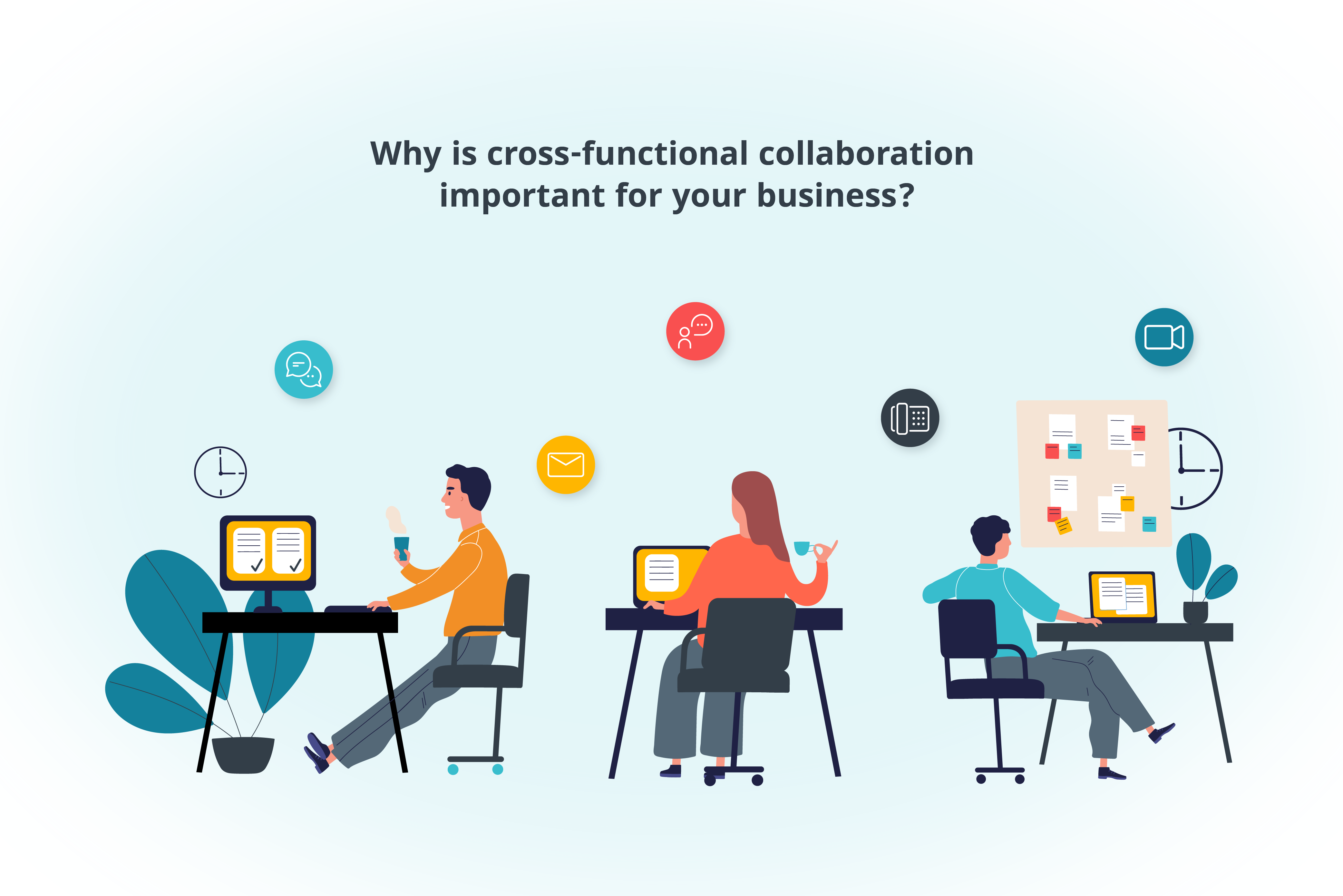In recent years, the idea of having teams work on projects has been the go-to for most companies, regardless of their size. Having team members of different disciplines collaborate on a shared goal has proven more effective than each department working in their own silo, especially when using cross-functional collaboration frameworks.
If done right, cross-functional collaboration has the potential to get more things done in a shorter period of time.
What is cross-functional collaboration?
Cross-functional collaboration is when team members from different departments (tech, marketing, operations, etc.) at a company join forces to work together on a common project or goal. They usually do this using collaborative tools, like b-hive Communicator.
This model works for numerous industries and projects, from building or creating a new product to setting up for a trade show or presentation. In a well-laid out cross-functional framework, all members understand their roles, responsibilities, and the team’s overall goal.
Why is it important in business settings?
With the technology constantly evolving, businesses are scrambling to outperform their competition. To do this, they need to make sure they are on top of their game and employees are able to perform at their best.
Cross-functional collaboration helps ensure that one department or individual is not being overworked or taking on the majority of the work. Instead, it allows those tasks to be spread out across different team members.
It’s especially important for the following reasons:
- Sets a clear and direct goal for all the projects.
- Motivates team members.
- Allows for an open-minded approach when tackling tasks.
- Easier management of teams.
- Little to no conflicting personal goals.
- Easier to hold each team member accountable.
- Allows for proper and better communication.
What are the benefits and challenges of cross-functional collaboration frameworks?
While cross-functional collaboration has proven to be the go-to for most businesses, this doesn’t happen overnight. Building a team takes time and effort, but once the team is assembled, cross-functional collaboration can work like a charm.
Cross-functional collaboration benefits
Here are some of the key benefits of cross-functional collaboration.
Allows for leadership and managerial growth
When using cross-functional collaboration, different leadership opportunities arise. Cross-collaborating allows more team members to give direction and solve problems, helping build their leadership and managerial skills and opening up new opportunities for growth.
Allows for proper and fluid communication
Effective communication is the cornerstone for a successful team.
With proper, fluid, and frequent communication, sharing ideas and solutions is easier and more efficient. Teams can also have a better understanding of which tasks are complete and those that are yet to be done. It also gives room for constructive criticism.
Builds the team’s spirit
The process of cross-functional collaboration helps team members feel motivated and it gives them a chance to have healthy competition, allowing them to grow and challenge themselves.
Cross-functional collaboration also creates unity in teams, which helps team members build confidence and patience by:
- Setting goals that the whole team understands.
- Identifying the strengths of all the members.
- Selecting team leaders or managers who are open-minded and problem solvers.
- Investing in collaborative tools and software.
Encourages diversity
Working in teams means getting to work with new people, all of which have different strengths. For example, a team with both tech and non-tech members will naturally be encouraged to exchange ideas and approaches to problems and or solutions.
Getting an understanding of what each team member brings to the table is a big plus for the business as a whole.
Engages all the participating team members
Sometimes it’s hard to get all team members to participate when working on a large team. Cross-functional collaboration allows companies to break down their workforce into smaller teams, so everyone is able to engage with the project and have their voice heard.
Gives room for innovative ideas
Having a cross-functional team allows you to explore new approaches and ideas rather than sticking with what has always been done. This allows for more creativity, innovation, and experimentation.
Gives you and your team a better insight
Working in a team allows you to share ideas and encourages creativity. When brainstorming as a group, new perspectives and insights are brought forth from each team member’s unique expertise and experience.
Cross-functional collaboration challenges
There are always two sides to a coin. This also applies to cross-functional collaboration. Here are some challenges when it comes to cross-functional collaboration frameworks.
Derailing from the project’s goals and vision
When working in teams, it is easy to steer away from the project’s goals and vision. Remember the saying, “too many cooks…?” In projects, this can come in the form of too many ideas which can derail a team from achieving its goals.
Learning curve
When a new tool is introduced to a team, especially a new collaborative tool, it’s normal for the team to experience a learning curve. Team members may require extra time to complete tasks, so it’s important to set aside extra time so they can get familiar with the tool or software.
Misunderstanding of responsibilities and goals
It’s important to delegate and give each team member a well-outlined list of responsibilities. Failing to do so could result in the worst-case scenario: two members working on the same task, while another task goes unassigned.
Social loafing
Working in teams means that everyone is contributing their bit to the project. Yet, during this process, some team members might take advantage of their team members. In a perfect world, everyone should be doing their part. But in this world, it is not rare to come across someone who is riding on other people’s waves.
What are examples of cross-functional collaboration?
Many large companies today take a cross-functional collaborative approach, especially when it comes to building and improving their products and services. One of the best examples is Apple.
Unlike what many believe, Apple is not in the business of building and creating hardware and software, but rather, the company is in the business of creating the user experience. Hence, all employees from design, production, marketing, all the way down to their supply chain team, must work cross-functionally with each other to deliver the best product possible.
If you are looking to unlock untapped potential in your team, you might want to consider a cross-functional collaboration approach. Luckily, Broadvoice’s communication and collaboration tools can help. To get started, schedule a demo today!









